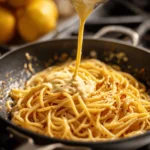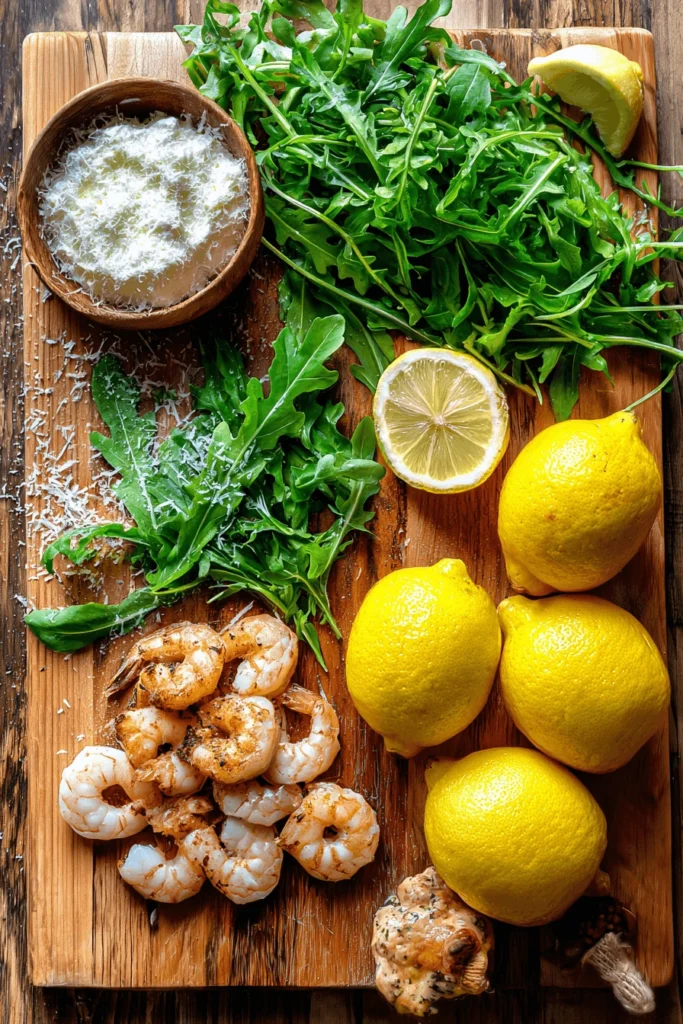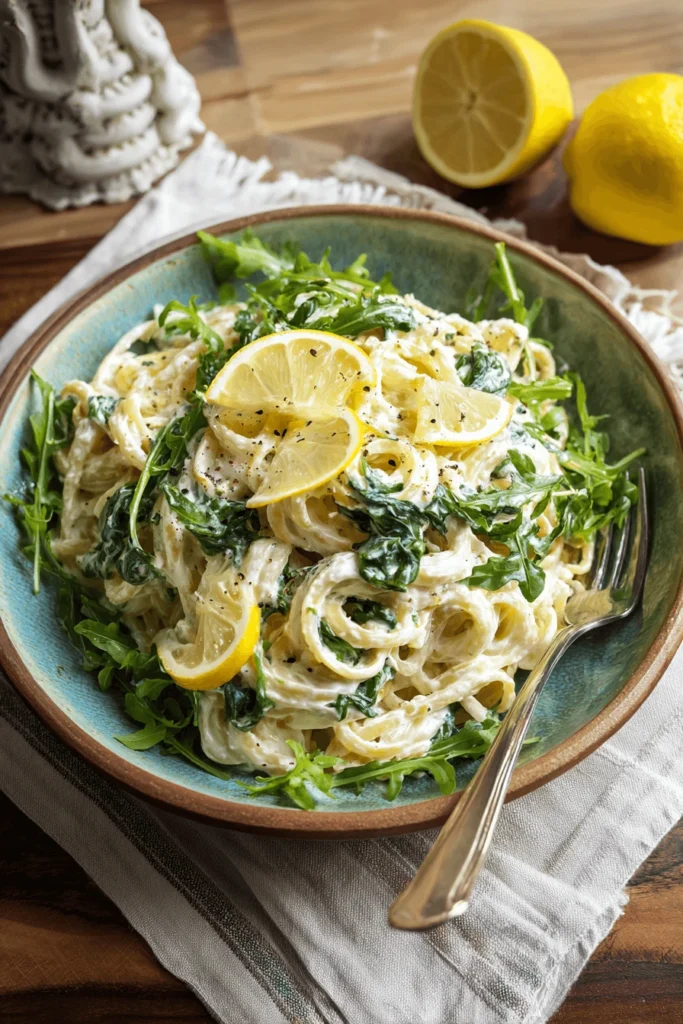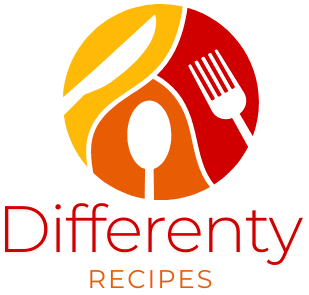If pasta could flirt, lemon ricotta pasta would be the charming guest at the dinner table—creamy enough to feel indulgent, yet zesty enough to keep you coming back for another forkful. Imagine silky strands of pasta swirled in a sauce that’s rich with ricotta, brightened with lemon zest, and rounded off with just the right pinch of herbs and parmesan. It’s comfort food with a sunny personality, the kind of dish that proves weeknight meals don’t have to be boring. Whether you keep it simple or jazz it up with chicken, shrimp, or even a baked version, this pasta checks all the boxes for quick, satisfying, and downright crave-worthy dinners.
Table of Contents

Lemon Ricotta Pasta
- Total Time: 25 minutes
Ingredients
12 oz (340 g) pasta (spaghetti, linguine, or your favorite)
1 cup (250 g) ricotta cheese, full-fat
½ cup (50 g) grated parmesan or pecorino
1 large lemon, zest and juice
2 tbsp olive oil or unsalted butter
2 cloves garlic, minced
1 cup reserved pasta water
Salt and freshly cracked black pepper, to taste
Optional add-ins:
1 cup arugula
8 oz shrimp, peeled and deveined
1 cup cooked chicken breast, sliced
Fresh herbs for garnish (basil, parsley)
Instructions
Cook Pasta: Bring a large pot of salted water to a boil. Cook pasta until al dente. Reserve 1 cup of pasta water, then drain the pasta.
Prepare Sauce: In a large mixing bowl, combine ricotta, parmesan, lemon zest, and lemon juice. Mix until smooth.
Add Heat: In a skillet, warm olive oil or butter over medium heat. Add garlic and sauté for 30 seconds until fragrant.
Combine Pasta & Sauce: Add cooked pasta to the skillet. Pour ricotta mixture over pasta and gradually stir in reserved pasta water until sauce reaches desired creamy consistency.
Adjust Flavor: Taste and season with salt, pepper, and additional lemon juice if desired.
Add Optional Ingredients: Toss in arugula, cooked shrimp, or chicken for added flavor and protein.
Serve: Plate pasta in shallow bowls. Garnish with extra parmesan, fresh herbs, and a touch of lemon zest. Serve immediately.
Notes
For extra creamy sauce, whisk ricotta with a tablespoon of olive oil or butter before adding to pasta.
Adjust lemon juice for a more subtle or bold citrus flavor.
Reserve pasta water—it helps thicken the sauce and make it cling to noodles.
Serve with a side of garlic bread or a fresh salad for a complete meal.
- Prep Time: 10 minutes
- Cook Time: 15 minutes
Nutrition
- Serving Size: 4
What Is Lemon Ricotta Pasta & Why It’s Irresistible
Origins of Pasta al Limone and the Role of Ricotta
The roots of pasta al limone trace back to Southern Italy, where lemons thrive under the Mediterranean sun. Traditionally, this dish pairs pasta with lemon, butter, and parmesan to create a sauce that feels both delicate and luxurious. Enter ricotta cheese: the ingredient that takes this pasta from “nice” to “I need seconds.” Unlike heavy cream, ricotta delivers creaminess without weighing the sauce down. It clings to each noodle like velvet while letting the brightness of lemon shine through. That’s why when you put “lemon” and “ricotta” together in pasta, you end up with a flavor marriage that’s both refreshing and indulgent.
Key Flavors in Lemon Ricotta Pasta & How They Balance Each Other
So, what’s happening in this bowl of goodness? Think of it as a flavor triangle:
- Lemon zest and juice bring sharp, citrusy notes. The zest carries essential oils that perfume the sauce, while the juice gives it tang.
- Ricotta adds the creamy, mild backdrop. It’s slightly sweet, which tempers the sharpness of lemon.
- Parmesan or pecorino introduces a salty, umami punch that rounds out the dish.
- Fresh herbs like basil, parsley, or even arugula add earthiness and a pop of color.
This balance is why the dish works for almost everyone. If you love pasta nights, you might also enjoy trying corkscrew pasta, a fun shape that holds onto sauce beautifully.
Essential Ingredients & Variations of Lemon Ricotta Pasta
Choosing the Best Ricotta, Cheeses & Lemon Type
Not all ricotta cheeses are created equal. For a truly luscious lemon ricotta pasta sauce, full-fat ricotta wins every time. It’s thicker, creamier, and doesn’t water down your sauce the way part-skim sometimes does. If you can find fresh ricotta at a local market, even better—it’s less grainy and blends more smoothly with lemon.
When it comes to supporting cheeses, parmesan is the classic choice. It brings a nutty depth, while pecorino romano works if you prefer a sharper bite. Just remember, these cheeses are salty, so taste before adding extra salt to your dish.
Now, let’s talk lemons. If you can, choose organic or unwaxed lemons, especially since you’ll use zest. That bright outer peel holds the essential oils that infuse your sauce with the signature citrus fragrance. Pro tip: zest first, then juice—it’s nearly impossible to zest a squishy lemon half.
Variations: Lemon Ricotta Pasta with Arugula, with Shrimp, with Chicken & Bake Versions
Here’s where you can have fun with the recipe:
- Lemon Ricotta Pasta with Arugula: Toss in a handful of peppery arugula right before serving. The greens wilt slightly but keep their bite, balancing the creamy sauce.
- Lemon Ricotta Pasta with Shrimp: Quick-seared shrimp pair beautifully with the sauce’s citrus notes. They add protein without overpowering the delicate flavors.
- Lemon Ricotta Pasta with Chicken: Grilled or roasted chicken breast works wonderfully if you want a heartier meal. Slice it thin and lay it on top so it doesn’t dry out.
- Lemon Ricotta Pasta Bake: Take leftovers (if you have any!) or prep a larger batch, layer with extra parmesan and a sprinkle of breadcrumbs, then bake until golden. It transforms a light pasta into cozy comfort food.

For another creamy and comforting option, this Marry Me Chicken Pasta is always a crowd-pleaser.
Step-by-Step Recipe: How to Make Lemon Ricotta Pasta
Cooking the Pasta & Reserving Pasta Water
The foundation of great lemon ricotta pasta is, of course, the pasta itself. You’ll want to cook your noodles until just al dente—tender but still with a little bite. Why? Because pasta continues to cook once you toss it with hot sauce, and nobody craves mushy noodles.
Shape matters too. Spaghetti and linguine give you a light, elegant feel, while rigatoni, penne, or fusilli grab onto that creamy sauce in every nook and cranny. Don’t be shy about trying different pasta shapes; each one changes how the dish feels on your fork.
Most importantly, don’t drain away that liquid gold—the starchy pasta water. Reserve at least one cup before draining. That starchy water is your best friend for creating a smooth sauce. It helps the ricotta and lemon juice cling to the pasta, preventing a dry or clumpy texture.

Preparing the Lemon Ricotta Pasta Sauce
Now for the star of the show: the sauce. Start by whisking together ricotta, freshly grated parmesan, lemon zest, and lemon juice in a large mixing bowl. This no-cook method keeps the flavors bright and fresh. You’ll notice the mixture is thick at first—don’t panic, it’s supposed to be.
Next, ladle in a bit of the reserved hot pasta water, whisking until it transforms into a creamy, silky sauce. Add more water as needed until it reaches your ideal consistency. Taste as you go: need more brightness? Add extra zest. Too tart? Balance it with a drizzle of olive oil or a little more parmesan.
Once your pasta is ready, toss it directly into the sauce bowl and give it a good stir. The heat from the noodles warms the sauce, coating every strand or piece evenly.
Finally, sprinkle on some cracked black pepper, fresh basil, or chili flakes for that final chef’s kiss.
Customizing Flavor & Texture
How to Make the Lemon Flavor Shine Without Overpowering
One of the biggest questions when making lemon ricotta pasta is how to get that bright, zesty flavor without turning the dish into a sour punch. The trick lies in balancing zest and juice. Zest brings aromatic oils that hit your nose first, giving the illusion of more lemon without extra acidity. Juice adds tang, but too much can overwhelm the delicate ricotta.
Timing matters too: add juice toward the end of mixing so the flavor stays vibrant. A sprinkle of fresh herbs—basil, parsley, or a touch of arugula—softens the sharp edges and adds a fresh, green note. The result? Pasta that tastes lively, bright, and balanced in every bite.
Fixing Common Issues: Too Thick Sauce, Bland Sauce, Texture Problems
Even experienced cooks run into hiccups. Here’s how to troubleshoot:
- Sauce too thick: Gradually whisk in reserved pasta water or a splash of vegetable broth until you reach the desired creaminess.
- Sauce too bland: Add a pinch of salt, extra parmesan, or a little freshly cracked black pepper. A teaspoon of lemon zest can also elevate the flavor.
- Texture issues: If the ricotta is clumping, warm the mixture slightly over low heat while stirring, or briefly blend until smooth. Don’t have a blender? Whisk vigorously and the heat from pasta will help.
Small adjustments like these make a world of difference, turning a good pasta into a truly memorable meal. Pro tip: for a slightly richer flavor, swirl in a tablespoon of butter or chicken fat at the end—this creates a glossy, silky sauce that clings beautifully.
Looking for a refreshing pairing? This Tomato Lemonade offers a bright and unique drink to serve alongside pasta.
Dietary Adaptations (Vegetarian, Gluten-Free, etc.)
How to Easily Make This Lemon Ricotta Pasta Vegetarian
The good news: lemon ricotta pasta is naturally friendly to vegetarians if you skip meat additions. To keep it hearty, you can add roasted vegetables such as zucchini, cherry tomatoes, or bell peppers. For protein, chickpeas or white beans are excellent options—they blend seamlessly with the creamy ricotta sauce.
If you normally cook with chicken or shrimp, simply omit them. The key is to enhance flavor with aromatic herbs and spices. Fresh basil, parsley, or even arugula will give your pasta that restaurant-quality touch without needing meat.
Making It Gluten-Free & Other Special Diets
Going gluten-free? Use a high-quality gluten-free pasta made from rice, corn, or quinoa. Cook it according to package instructions, and be sure to reserve some pasta water—it’s essential for the sauce, just like with traditional pasta.
For those who are dairy-free, ricotta alternatives like almond ricotta or cashew cream work well. These alternatives may be slightly less creamy than traditional ricotta, but adding a small drizzle of olive oil helps mimic the silky texture.
Even picky eaters or those with multiple dietary needs can enjoy this dish. With small tweaks, lemon ricotta pasta remains vibrant, creamy, and delicious without compromising flavor.
Storage, Reheating & Serving Suggestions
How Do You Store and Reheat Lemon Ricotta Pasta
Leftovers? No problem! Lemon ricotta pasta stores well in an airtight container in the refrigerator for up to 3 days. When reheating, avoid the microwave straight from cold, as the ricotta can become grainy. Instead, gently warm the pasta in a skillet over low heat, adding a splash of reserved pasta water or a little milk to bring the sauce back to a creamy consistency. Stir frequently until heated evenly.
For freezer storage, it’s better to freeze the sauce separately from the pasta. The ricotta sauce can be frozen for up to one month, then thawed and mixed with freshly cooked pasta. This preserves both texture and flavor without losing creaminess.
Serving Suggestions + Pairing Ideas
Presentation matters! Serve your lemon ricotta pasta in shallow bowls, sprinkled with freshly cracked black pepper, extra parmesan, and a few lemon zest shavings. Garnish with a handful of fresh arugula or basil for a pop of color and subtle peppery bite.
For protein additions, consider:
- Grilled chicken slices for a hearty dinner
- Pan-seared shrimp for a touch of elegance
- Roasted vegetables for a vegetarian-friendly option
Sides like a light salad or garlic bread complement the citrusy richness of the sauce beautifully.

Frequently Asked Questions (FAQs)
How to Easily Make This Lemon Ricotta Pasta Vegetarian?
Good news—this recipe is already mostly vegetarian! To enhance protein without meat, add roasted vegetables, white beans, or chickpeas. Skip shrimp or chicken, and focus on fresh herbs like basil, parsley, or arugula to maintain flavor depth.
How Do You Store and Reheat Lemon Ricotta Pasta?
Store leftovers in an airtight container in the fridge for up to 3 days. Reheat gently in a skillet over low heat, adding a splash of reserved pasta water to restore creaminess. For freezing, keep the ricotta sauce separate and thaw before mixing with freshly cooked pasta.
My Pasta Sauce Turned Out to Be Too Thick. What Can I Do to Fix It?
Simply whisk in some reserved pasta water, vegetable broth, or even a little milk. Gradually add liquid until the sauce reaches a silky, smooth consistency.
Can I Make This Pasta al Limone Gluten-Free?
Absolutely! Use a high-quality gluten-free pasta made from rice, corn, or quinoa. Cook according to package instructions and reserve pasta water for the sauce, just like with regular pasta.
Is the Lemon Flavor Overpowering in This Dish?
If the sauce tastes too tangy, balance it with extra ricotta, parmesan, or a drizzle of olive oil. Zest is more aromatic than sour, so using more zest and less juice can brighten the flavor without overwhelming your taste buds.
The Sauce Is a Little Bland for My Taste. How Do I Fix It?
Add a pinch of salt, more parmesan, fresh cracked pepper, or an extra teaspoon of lemon zest. Herbs like basil, parsley, or arugula also boost flavor naturally.
I Don’t Have a Way to Blend the Sauce. Do I Have to?
Not at all. Whisk the ricotta, lemon, and cheese vigorously, then toss with hot pasta. The residual heat will help smooth the sauce. Blending is optional, mainly if you prefer an ultra-silky texture.
Health Benefits & Nutritional Info
Approximate Nutrition for a Serving of Lemon Ricotta Pasta
A standard serving of lemon ricotta pasta (about 1.5 cups) provides:
| Nutrient | Amount per Serving |
|---|---|
| Calories | 320–380 kcal |
| Protein | 12–15 g |
| Fat | 14–18 g |
| Carbohydrates | 38–42 g |
| Fiber | 3–4 g |
| Sodium | 400–500 mg |
Keep in mind that adding chicken, shrimp, or extra vegetables will adjust these numbers slightly. Using whole-grain or gluten-free pasta can also increase fiber content while maintaining flavor.
Health-Wise Pros & Trade-Offs
- Pros:
- Lemons are rich in vitamin C and antioxidants, which support immunity and overall health.
- Ricotta cheese provides protein and calcium for strong bones and muscles.
- Fresh herbs add vitamins, minerals, and flavor without extra calories.
- Trade-Offs:
- The dish contains moderate fat from ricotta and cheese, so portion control matters if you’re tracking calories.
- Sodium can be high due to cheese, but adjusting salt and using reduced-sodium cheeses can help.
With thoughtful ingredient choices, lemon ricotta pasta balances indulgence and nutrition, making it a satisfying meal that doesn’t feel heavy or overly rich.
Tips, Tricks & Pro Tips from Experts
Pro Tips for Perfect Creamy Texture Every Time
Getting that silky, clingy sauce is easier than you think. Always reserve pasta water—the starch in the water is what makes the ricotta coat each noodle beautifully. Whisk the sauce with a little water gradually to avoid clumping. If your ricotta is grainy, warm it gently over low heat or whisk vigorously as you combine it with the hot pasta. For extra richness, swirl in a tablespoon of butter or chicken fat at the very end.
Expert Tricks for Flavor Layering and Presentation
- Layer flavors: Add lemon zest first for aroma, then juice for tang. Top with freshly cracked pepper and fresh herbs to make each bite pop.
- Plating: Use shallow bowls for a more elegant presentation. Sprinkle grated parmesan or pecorino on top and a few microgreens for a visual lift.
- Variations: Try tossing in arugula just before serving, or add lightly seared shrimp or sliced grilled chicken for heartier options.
- Bake versions: If making a lemon ricotta pasta bake, layer extra cheese and breadcrumbs on top and bake until golden. This gives a crispy topping that contrasts perfectly with the creamy noodles.
These small adjustments make the difference between a good pasta and a dish your friends will rave about. Don’t hesitate to experiment—lemon ricotta pasta is forgiving, versatile, and full of flavor.
Conclusion
Lemon ricotta pasta is a dish that’s as versatile as it is delicious. From light weeknight meals to impressive dinner parties, it adapts easily to vegetarian, gluten-free, and protein-packed variations. Its creamy texture, bright lemon flavor, and endless topping options make it a crowd-pleaser. So, grab your pasta, ricotta, and a lemon or two, and get ready to create a dish that’s both comforting and zesty.
